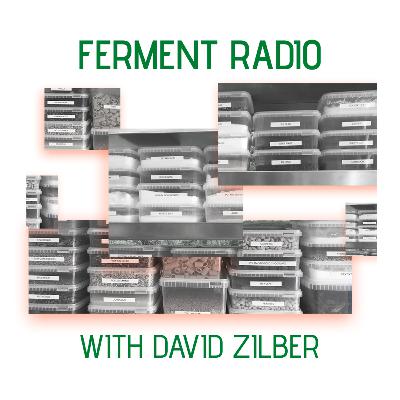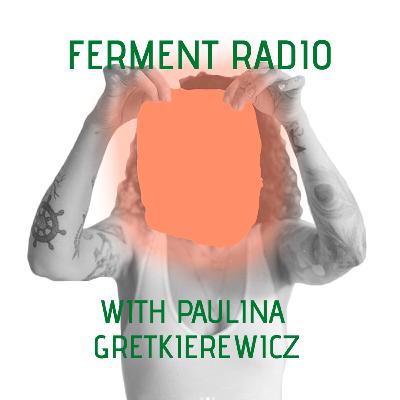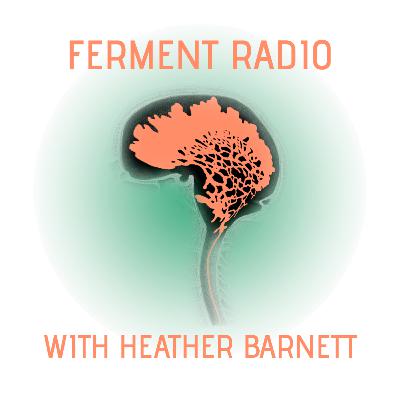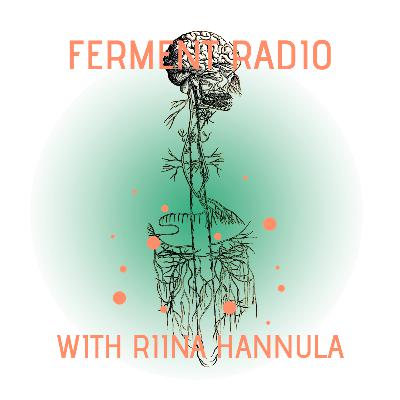Discover Ferment Radio
Ferment Radio

42 Episodes
Reverse
Bacteria are often considered ugly and stinky; something dangerous that wants to get on us, and that we need to protect ourselves from. Fermentation is one way to overcome that prejudice and find pleasure and beauty in what many people fear, misunderstand, or even loathe. Another way is art, which can utilize microorganisms as metaphors and aesthetic experiences. But, do things need to be pretty so they can talk to us?
In this episode of Ferment Radio, we go on a journey through the artistic work of Anna Dumitriu. Her interdisciplinary practice merges art, science, and technology to explore issues around health, disease, and the societal impact of scientific progress. Anna collaborates closely with scientists and historians, incorporating biological materials like bacteria and DNA into her installations, sculptures, and performances. Through her work, she invites viewers to reconsider common perceptions of the natural world.
---
Send in a voice message: https://podcasters.spotify.com/pod/show/fermentradio/message
We choose our tools, and in return, our tools shape us. Tools can be an opening to new possibilities, but also a limitation. What makes the workspace of a fermenter? What tools are there available? How do these tools influence the process?
In this episode, we sneak peek into the kitchen of David Zilber, chef, fermenter, food scientist, and author of The Noma Guide to Fermentation. Guided by David’s voice, and powered by imagination, we stroll around his lab at Chr. Hansen in Hørsholm, Denmark.
This is the second part of our interview with David Zilber. Check out episode 36 to learn more about the importance of “little” ferments in the “big” food system.
---
Send in a voice message: https://podcasters.spotify.com/pod/show/fermentradio/message
It looks like a square, monochromatic, glass slide photo, and not only because of the material it is made of, but also because it could belong to a different time. It feels as if the face that emerges from there and gazes at you must have posed for a very long time for the exposure to do its job. Only if you could stare at it uninterruptedly for days, or years, would you be able to notice that the image is in constant change. It is alive. It comes from nowhere, and disappears into what comes next. It is called yeastogram.
Yeastograms are living images made of yeast cultures growing on agar plates and carved with UV light. One of the people who have mastered this technique is Johanna Rotko, a visual artist based in Lahti, Finland. Yeastograms are a lot about fine-tuning the technology. But it goes beyond that. It is also about bringing the imagery of deceased people back to life, waiting for the uncontrollable to do its job, killing and letting live. In other words, it is about time. It is about patience.
---
Send in a voice message: https://podcasters.spotify.com/pod/show/fermentradio/message
She asks the plants for permission before foraging them. She sings to her fermentation jars. She prepares funerals for her kombucha scobies. She gives names to her ferments. She observes the moon cycles. She’s a witch. But what does it mean to be a witch today?
I asked this to Paulina Gretkierewicz, a forager, a fermenter, and a witch. She transforms seasons and landscapes around Copenhagen, Denmark into edible and drinkable experiences. She calls this “Applied Poetry”, which is also the name of her business, focused largely on handpicked, fermented, and oxidized teas.
Let’s ferment our way into becoming a witch.
---
Send in a voice message: https://podcasters.spotify.com/pod/show/fermentradio/message
Have you ever heard of slime mold?
These organisms might not have a nervous system or even a brain, but they have impressive problem-solving abilities. Slime mold can navigate through mazes and find the most efficient routes to find food. Some researchers have already been inspired by them to design more efficient transportation networks, urban planning, and solving optimizational problems. However, they are shrouded in a haze of mystery. They are hard to like, observe, and classify.
In this episode, together with Heather Barnett, an artist and university professor at Central Saint Martins University of the Arts London, working with natural phenomena, complex systems, and playful pedagogies, we look at slime mold beyond their instrumental features and focus on their intrinsical importance as a remarkable lifeform. Instead of thinking: What can we extract from these species? We want to ask ourselves: What can we actually learn from them?
Join us in this fascinating and meandering, or shall we say, “slimemoldesque” conversation.
---
Send in a voice message: https://podcasters.spotify.com/pod/show/fermentradio/message
A healthy food system encourages the production and consumption of foods that support a balanced gut microbiome. It reduces food waste and gives preference to natural preservation methods. It uplifts food, not only for its nutritional value but also as cultural heritage and an expression of diversity. It is also mindful of the energy spent in order to process food.
All these characteristics of a healthy food system sound very much like the definition of fermented foods. It may seem like a simple solution, but diagnosing and improving the complexity of the food system, which is both global and fragmented, is a huge challenge.
There are not that many people in the world who can say they have extensive hands-on experience working in different areas of that vast system. David Zilber is definitely one of them. From a butcher shop in Toronto to the Fermentation Lab of the acclaimed restaurant Noma, Copenhagen, and to the labs of Chr. Hansen, a giant bioscience company in Hørsholm, Denmark, David Zilber has garnered multiple and fascinating perspectives on food and the system around it. Ferment Radio had the pleasure to talk with David in his own lab, where we reflected more about this incredible journey and his ever-evolving views on the food system that we are all part of.
---
Send in a voice message: https://podcasters.spotify.com/pod/show/fermentradio/message
Garden. It invites us to sit down and watch things grow. It makes us work with gazillions of other species to make them flourish. Silent observation or site-specific, mindful labor can be a form of wondering: seeing magic in what’s common and perceiving what’s repetitive with new eyes.
This is how Noora Sandgren, a visual artist and art educator from Finland, works in her family garden. She collaborates with climates, insects, and expired light-sensitive material to create cameraless photograms of shared chemistry of composting organic matter, microbes, human breaths, and sunlight.
In this episode, Noora takes us to her garden where she wonders while taking lensless images and patiently waits for long exposures for the magic to happen.
---
Send in a voice message: https://podcasters.spotify.com/pod/show/fermentradio/message
We associate these institutions with petrified displays, and long-gone worlds that are alien to our own experience: museums. Whether we like it or not, they play a crucial role in preserving heritage.
Can heritage be something alive and ever changing? It seems that yes. At least ARTIS-Micropia, a one-of-a-kind museum showing the invisible world of micro-organisms, is doing that. ARTIS-Micropia is a museum in Amsterdam in which visitors can learn more information about microbes, and see live microbes on display too.
The museum fills a gap between the general public’s knowledge on microroganisms, and the science behind microbiology. “Unknown is unloved” they say on their webpage, and they definitely want to change that.
On Ferment Radio’s new episode, we talk with ARTIS-Micropia’s lab technicians Loek van Buuren and Eline van Bloois about curating microbes, preserving what is alive, and dreaming about immersive microscopial experiences, which could allow us to float with microbes in their micro universe.
---
Send in a voice message: https://podcasters.spotify.com/pod/show/fermentradio/message
Can we intentionally influence our nervous system through what we do? If so, could we also activate the main nerve of our parasympathetic nervous system known as vagus nerve? This is the central communication pathway between the gut and the brain, and between microbiota and our nervous system. Could we interact with our gut microbiota and our gut microbiota interact with us?
In this episode of Ferment Radio, together with Riina Hannula, we start with Microbial Medi(t)ation, an instructional audio that guides us through selected movements from yin- and hatha yoga to stimulate the vagus nerve. With this meditation, we wonder if it is possible to embody scientific facts and if our well-being involves the well-being of our microscopic companions as well.
Riina Hannula, an artist and doctoral student in sociology at The Centre for the Social Study of Microbes at the University of Helsinki, studies humans as holobionts from a gut-brain-axis point of view and looks into how microbes think, feel, and behave with humans.
---
Send in a voice message: https://podcasters.spotify.com/pod/show/fermentradio/message
We communicate with the outside world based on the information we receive through our senses. But just like fingerprints, no two people have the same brain anatomy, and therefore, no two people can sense the world identically. We can’t experience how other bodies feel, but we can attempt to describe it.
Today, together with Pia Lindman, an artist and researcher working with performance art, healing-as-art, installation, microbes, architecture, painting, and sculpture, we dive into the uniqueness of bodily experiences; even those caused by microorganisms. Pia calls this, the subsensorial.
---
Send in a voice message: https://podcasters.spotify.com/pod/show/fermentradio/message
The notion of “animal rights”, meaning that we recognize their universal, intrinsic rights, regardless if some animals are more useful for humans or not, is being talked about more and more these days. However, we can’t fully understand the lives of animals, and as result, we can’t understand our own lives without microbes and our relationship with them. Our lives depend on them. In other words, we belong to them.
This episode revolves around speculative microbial perspectives in the work of Terike Haapoja. Terike is a visual artist based in New York, whose work investigates animality, multispecies politics, cohabitation, repairing connections, and the existential and political boundaries of our world. Her research and work put a special focus on issues that emerge from the anthropocentric worldview of Western traditions.
---
Send in a voice message: https://podcasters.spotify.com/pod/show/fermentradio/message
Through language, we not only reflect our relationship with the world but also shape it. For example, what does the conviction that we need to “exterminate all superbugs” tell us about humans? Could it be that antimicrobial resistance, which causes antibiotics to become ineffective against microbial infections, is in part driven by a human desire to separate human from nature and eradicate what is ‘impure’, different, or misunderstood?
On the 30th episode of Ferment Radio, together with Iona Walker, a medical anthropologist living and working in Edinburgh, Scotland, we search for different perspectives on this alarming issue and find inspiration in books, art, films, and poetry.
We look for cracks, soft spots, and ambiguities to unlearn what we think we know for sure and exercise a new language that could help reshape our relationship with the world, including microbes. Join us in this exciting conversation!
---
Send in a voice message: https://podcasters.spotify.com/pod/show/fermentradio/message
On Ferment Radio, we have often talked about how artists use technology and science in order to tackle the microbial world. Do you remember the episode “Play that fungi music!” with Tosca Terán? Or “Interspecies collaborations” with Mindaugas Gapševičius? Some people refer to this kind of practice as “bioart”: the happy place where experimentation and process are more important than concrete results.
Our guest today is Laura Beloff, an artist, and researcher working at the intersection of art, science, and technology. Laura is also an associate Professor, and Head of the Visual Cultures, Curating, and Contemporary Art Program (VICCA) at Aalto University, in Helsinki, Finland. On this episode of Ferment Radio, we will delve into the dynamic interdisciplinary niche that likes to collaborate with microbes; reflect on the ethics of working with living organisms; and discuss the incompatibility of a creative endeavor within a neoliberal reality. Oh, and we will also talk about ticks!
As Laura Beloff points out: artists are antennas for societal moods, and there is a reason why they engage with microbes. And what’s the reason?
Stick around and tune into the 29th episode of Ferment Radio to find out!
---
Send in a voice message: https://podcasters.spotify.com/pod/show/fermentradio/message
For centuries, fermention has had an important role in the evolution of agriculture. But the idea that fermentation can be treated as a paradigm for understanding place-based change is one steap ahead.
The 28th episode of Ferment Radio explores how land use and management is related to the production and consumption of fermented beverages —a research area Colleen C. Myles calls “fermented landscapes.” That term functions as a metaphor for understanding landscape transformation and the co-evolution of humans, agriculture, and microbes.
Together with Colleen C. Myles, Associate Professor at Texas State University, rural geographer, and political ecologist, let's zoom out, look for the sweet spot where micro and macro meets, and think how fermentation is intertwined with placemaking.
---
Send in a voice message: https://podcasters.spotify.com/pod/show/fermentradio/message
We use them all the time. Metaphors allow us to make sense of things we cannot comprehend. What metaphors do we commonly use to understand microbes? Bacteria are bugs, and we certainly are at war with them. Such a stand contributes greatly to our antagonistic relationship with microbes. But, can we revalue our relationship with microbes through metaphors? Could metaphors help us reconsider habits and economies related to our co-existing with bacteria, particularly something as serious as anti-microbial resistance? In this episode of Ferment Radio, we look for answers to these questions with Jessica Maccaro, a PhD candidate at the McFrederick Lab, University of California, Riverside, working with insects, fungi, and science communication.
---
Send in a voice message: https://podcasters.spotify.com/pod/show/fermentradio/message
In 2015, while in grad school, Cecilia Westbrook made yogurt out of her vaginal flora, as an experimental side-project. A journalist friend of hers wrote about it, and the article got published on Vice. It immediately went viral, spawning a number of copy-cat publications that re-edited the original text but never added more content, let alone created space for dialogue or reflection.This situation caused problems with her academic institution, since at the moment she was undergoing PhD studies, and triggered a landslide of misogynistic remarks towards her, many of which can still be found online. For these reasons, she had to refuse to comment on the harmless, yet (for some people) controversial yogurt.Now, 7 years after, Ferment Radio has the great pleasure to learn more about that particular yogurt, and the avalanche it caused, directly from Cecilia Westbrook.
---
Send in a voice message: https://podcasters.spotify.com/pod/show/fermentradio/message
Last year, an article titled "Lost in the Brine!” was published on the Eater. The author, Miin Chan, aka Dr Chan, says what most people don’t want to admit: while the fermented foods industry evangelizes products rooted in global, often East Asian, traditions, its most visible faces are predominantly white.As a white host of a fermentation-related podcast myself, whose guests, so far, are predominantly white, I had felt the urge to comment on that issue already for a while. Reading this article assured me about the urgency of this topic, and that Miin is a perfect guest to share her views with us. Miin Chan is a medical doctor, researcher, ferment activist, and food literacy advocate. She is a PhD candidate at the University of Melbourne researching the effects of fermented foods on chronic disease via the gut microbiota. Miin Chan’s research is scientific and evidence-based, and it aims to demystify some of the most overstated narratives about fermentation. She is also critical, from a scientific and diverse perspective, about how the food industry capitalizes on fermentation. In this episode of Ferment Radio, we will focus on this problem, and how the fermentation industry exists within a system that is inherently racist.
---
Send in a voice message: https://podcasters.spotify.com/pod/show/fermentradio/message
Vaginal flora consists largely of Lactobacillus. This particular type of bacteria can affect everything, from developing certain diseases to fighting infections, and from getting pregnant to having a miscarriage. If the vaginal microbiome is imbalanced, there’s a risk for developing vaginosis, a type of vaginal inflammation. Some sources say that 75% of people with a vagina will experience vaginosis at least once in their lifetime. Moreover, people from more disadvantaged groups are more likely to experience it. Why is then vaginal health still a taboo topic?In this episode of Ferment Radio, we ask this and many other questions to Giulia Tomasello, a designer committed to innovating vaginal healthcare with biotechnology and interactive wearables.
---
Send in a voice message: https://podcasters.spotify.com/pod/show/fermentradio/message
Food is something quite peculiar. On the one hand, it is very intimate: we put it in our mouths, it nourishes our bodies, and we share it with the people we love. On the other hand, big corporations capitalize from it, turning it into a global political product. Njathi Kabui (Chef Kabui), a Kenyan-born, US-based organic chef is committed to raising awareness around food, and therefore restoring broken relationships with the land, with one another, and with ourselves. He is also an anthropologist, urban farmer, food activist, and strategist. He calls his approach “Afro Futuristic Conscious Cuisine”, and it’s anchored to the belief that colonialism not only took people’s beliefs, land, and culture, but it also stripped them of their culinary practices. How can we ferment our way out of this?
---
Send in a voice message: https://podcasters.spotify.com/pod/show/fermentradio/message
Missionaries and explorers who arrived in the Americas in the 17th century interpreted what they encountered through their own viewpoint and interests. In this way, local shamanism was mostly understood in reference to spirits and souls; concepts that were present at that time in medieval Europe. But what would happen if we attempted to comprehend shamanism differently?The work of César Enrique Giraldo Herrera, a biologist, anthropologist and a PhD in Social Anthropology, questions our views on Amerindian shamanism and its colonial interpretation. He proposes that there is a much closer relationship between shamanic practices and microbiology than we could think. César wrote a book about this fascinating topic. It’s called “Microbes and Other Shamanic Beings”, and he’s our guest on the 22nd episode of Ferment Radio.
---
Send in a voice message: https://podcasters.spotify.com/pod/show/fermentradio/message
























